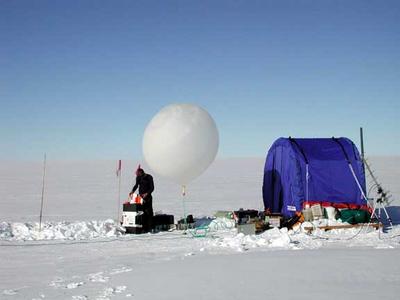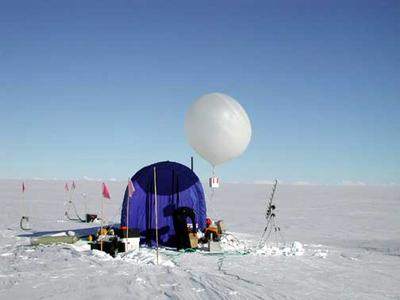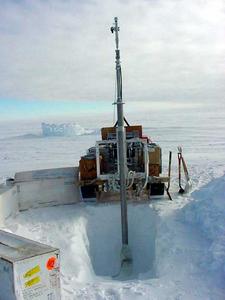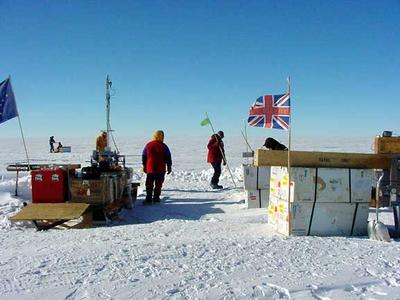30 December, 2002
It sure looks like a Circus around here.
Date: 12/30/02
Latitude: 88° 22’ 01.13” S
Longitude: 108° 32’ 11.15” W
Time of Observations: 11:00 PM local time
Temperature: -24 C / -11 F
Wind speed: 0 knot
Wind Chill: -24 C/ -11 F
Wind direction: Southerly
Meters of ice collected: 584 m
By Betsy Youngman
One of the unique features of the ITASE expedition is the fact that it
is a combination of many science disciplines working in a coordinated
effort to understand the dynamics of the Antarctic ice sheet and
climate patterns, both past and present. Among this team of 15
individuals there are four distinct disciplines of science. These
disciplines include deep and shallow radar, atmospheric chemistry, ice
core drilling and analysis and precise GPS mapping. The data collected
by each group helps to complete the “bigger picture” of the history and
future of the ice on the Antarctic continent. Thus, on any given day,
one can look around camp and see the drilling team securing ice cores
containing greater than 200 years of historical data, the radar and GPS
teams preparing their sleds to survey the ice and bedrock around the
area, or the atmospheric chemistry team collecting samples of the air
and snow for real time analysis of the recent atmosphere.
It is a fascinating sight to see the science equipment emerge from the
train to be set up on the snow surface like the three rings of a
circus. The sight of people walking about in colorful (and funny
looking) clothing and hats, helium balloons, yellow snowmobiles, giant
drills on sleds, large boxes, colorful flags, and even a kitchen with
wonderful smells wafting from the roof vent give our camp the look and
feel of a small traveling circus. But behind this colorful facade,
serious science is taking place at an intense pace.
The large helium balloon that is attached to the atmospheric chemistry
tent is an example of one of the fascinating and fun looking implements
of science. By carrying small instruments called sondes, this balloon
allows us to sample atmosphere as high at 20 kilometers above the
surface of the earth. From the information gathered by the sonde and
sent back to our computers by radio transmission we are able to know
the temperature, air pressure, relative humidity and ozone
concentrations throughout a vertical profile from the ground level to
the stratosphere (at approximately 20 kilometers). The ozone sonde, a
small pump contained in a small protective Styrofoam package, samples
the air for ozone. When running, this pump makes the sound of a little
cat purring. The purring pump draws air into a cylinder filled with a
salt solution of Potassium Iodide. Once inside the cylinder the ozone
in the air reacts with the salt solution creating a current. The amount
of current created by the reaction is recorded and transmitted by a
small computer chip attached to the pump. This information is passed
through a set of wires to the Viasala weather sonde taped onto the
outside of the ozone pump package. The weather sonde, exactly like
those used at McMurdo and other weather observing stations worldwide,
collects the temperature, relative humidity and air pressure data. This
instrument, in a small box the size of a one-liter milk container, also
contains a radio transmitter. Without the radio transmission
scientists would have to chase down and find the sondes, which often
travel hundreds of miles in their two-hour data collection flights (a
near-impossible task). However, we have the luxury of receiving our
data by an antennae and receiver located just outside our atmospheric
chemistry tent. These radio signals are translated by a modem and
computer into a graphical (visual) format allowing us to monitor the
data on a computer screen as it is being received. Each flight of the
weather and ozone-monitoring balloon brings us an enhanced
understanding of the atmosphere. Without the balloon one could only
sample the atmosphere close to the earth’s surface, with the balloon a
much larger area becomes within our reach.
So, while Betsy and Markus looked up into the sky today, following the
flight of the weather balloon to 18,000 meters, the drilling team
pushed down into the ice another 9 meters for a total depth of 54
meters. Meanwhile, in the Blue room, Brian and Jim prepared their radar
to seek out the ice layers all the way from the surface to the bedrock
some 3000 meters below us. In all, on any given day, this traveling
science team can look at a profile of the Earth from bedrock to the
stratosphere. And, like the circus, we are having fun while doing our
work and traveling from site to site.
We are now traveling again and are within one hundred miles of our
final stop on this tour, the South Pole. We hope to arrive in time to
celebrate the New Year and to complete our work at the last science
site. Looking back at our struggles to get started, it is incredible to
be this far in our journey. With five sites now completed, we are all
very excited to finally be nearing our destination.


Markus readies a balloon for launch.

Markus puts the final touches on the sonde.

The 3 inch drill ready to begin.

The drill site with the Union Jack.

Gordon and Paul with the 2 inch drill.
Contact the TEA in the field at
.
If you cannot connect through your browser, copy the
TEA's e-mail address in the "To:" line of
your favorite e-mail package.
|
